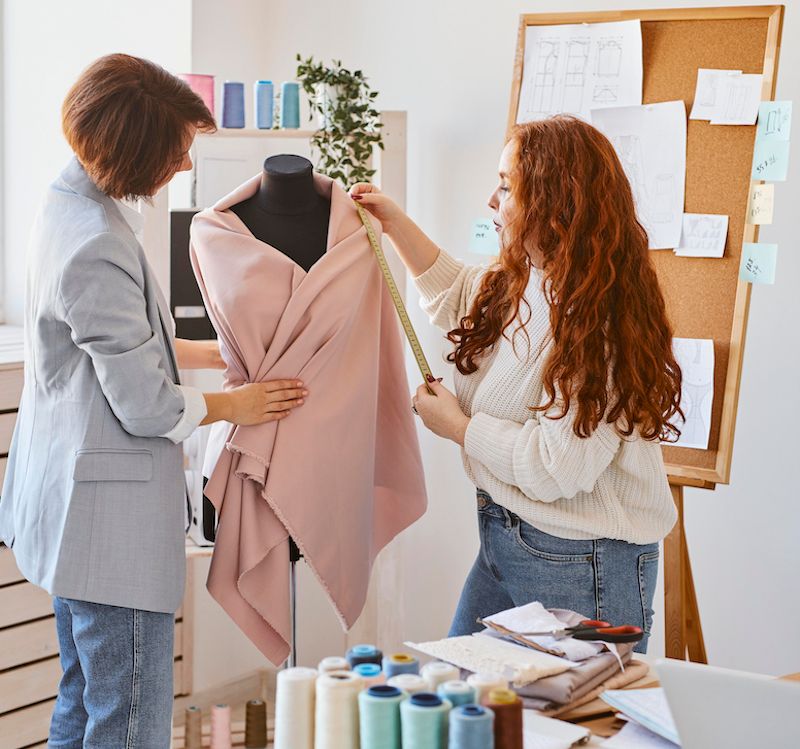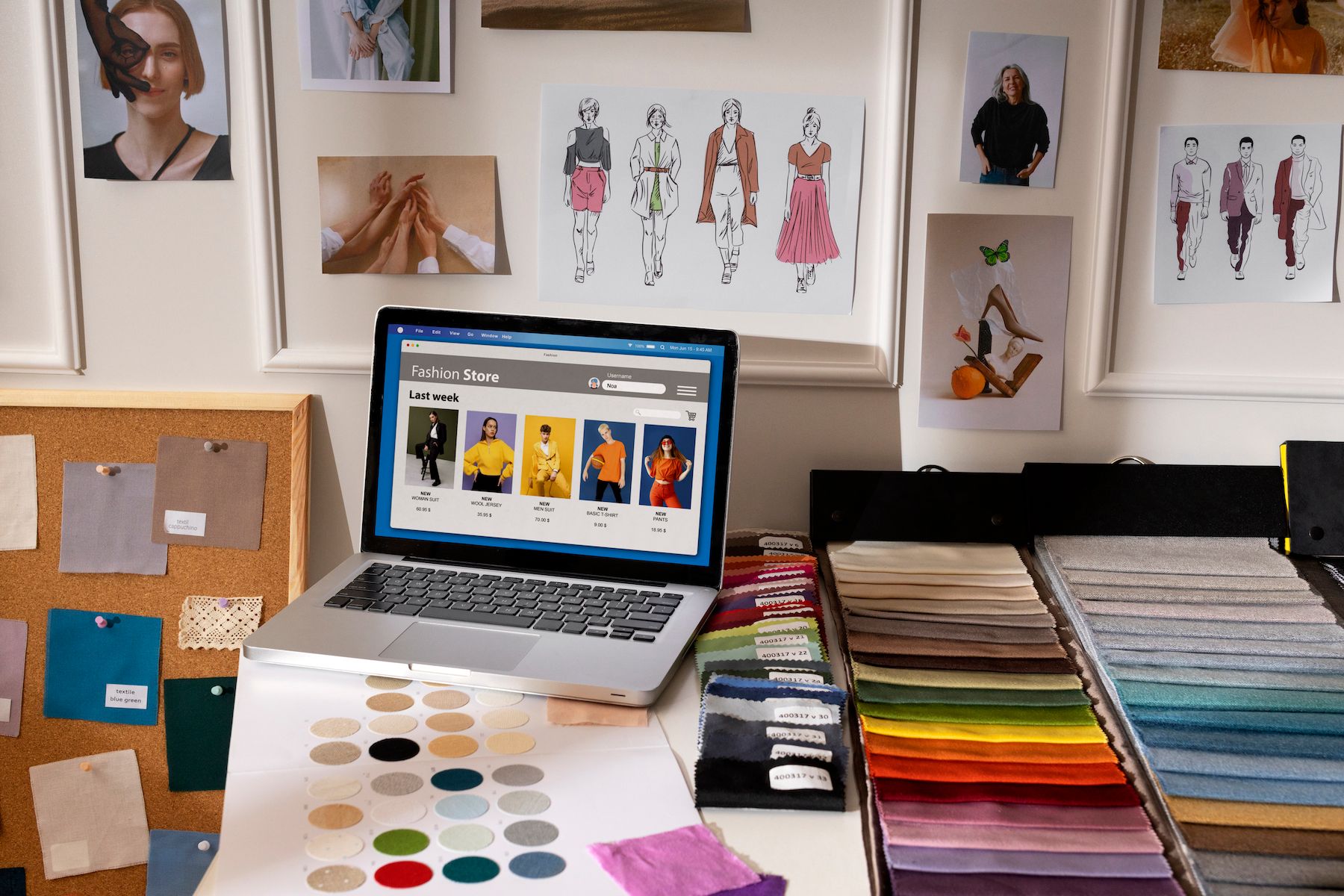Fashion Industry
How To Launch A Career In Fashion Merchandising: A Complete Guide
24 Jun 2025, 6:48 am GMT+1
The apparel market is valued at $1.84 trillion in 2025… and will experience a CAGR of 2.81 per cent between 2025 and 2028, per Uniform Marketing. Identifying pockets of growth means navigating a complex maze, however design and merchandising remain sought-after careers.
Fashion merchandising is the intersection of creativity and commerce—a strategic engine that drives the success of a brand. It's where market insight, consumer behaviour, and creative vision converge. A career in fashion merchandising offers a dynamic and rewarding pathway into the industry for those with a keen eye for style and strong business acumen.
Merchandising helps position the fashion brand in the market and increases profitability by aligning product availability with consumer preferences. For example, Zara's fast fashion model relies heavily on efficient merchandising to quickly adapt to changing trends, while luxury heritage brands like Louis Vuitton use high-end visual merchandising to emphasise exclusivity and craftsmanship. Effective merchandising also aids in managing inventory levels and avoiding overstock or stock-outs, ensuring that operations remain cost-efficient and customer-focused.
This guide is valuable for anyone interested in fashion merchandising as it provides a clear understanding of the key concepts, responsibilities, and real-world applications in the field. Whether a fashion graduate is exploring career options or a professional looking to pivot into fashion merchandising, the guide offers practical insights into how brands plan, promote, and sell fashion products effectively. By breaking down the processes and showcasing examples from leading retailers, it helps readers grasp the strategic and creative elements required for success.
What Is Fashion Merchandising?
The term ‘merchandiser’ implies buying and selling goods for profit. Hence, Fashion Merchandising is the art of ensuring that fashion products are available at the right price, at the right time and in the right amount to the customer. Retailers hire fashion merchandisers for the identifying consumer requirements, and planning and pricing a collection in accordance.
For example, a merchandiser at Zara might examine runway trends, social media movements, and sales data from previous seasons to determine that oversized denim jackets or neon colours are likely to be in demand. They then work to source these items from suppliers or manufacturers who can deliver on time and at the right quality and cost.
Another vital function of fashion merchandising is collaborating with fashion designers and manufacturers to bring trend-driven products to the market efficiently. Merchandisers often act as a bridge between the creative and commercial sides of fashion. They ensure that designs are aesthetically appealing and viable in terms of production and profitability.
Merchandisers also play a key role in deciding how products are presented in-store or online. This includes choosing mannequins, organising window displays, and designing floor layouts to enhance the customer experience and boost sales. A notable example is how brands like Uniqlo use uniform folding techniques and colour-blocked shelving to make products visually appealing and easy to browse and buy.
Moreover, inventory management and sales forecasting are crucial for minimising overstock and reducing markdowns. Fashion merchandisers must accurately predict customer demand and ensure that inventory levels align with sales trends. They analyse purchasing patterns, return rates, and emerging consumer behaviours to adjust stock accordingly.
What sets fashion merchandisers apart from designers or stylists is their focus on the business side of fashion, rather than the creative or promotional aspects. While a designer might create garments and a stylist assembles outfits for editorial shoots and showings, a merchandiser ensures that the right products are available, priced appropriately, and strategically presented to maximise sales and brand impact.
Skills Required for Fashion Merchandising

1. Trend Forecasting and Market Awareness:
A fashion merchandiser must stay ahead of trends and understand what consumers will want next season. This involves researching fashion shows, monitoring social media platforms, and analysing both retail data and trend forecasting. For example, a merchandiser might notice a rise in demand for sustainable fabrics on platforms like Instagram and adapt their collection by sourcing organic cotton pieces for the upcoming line.
2. Analytical and Numerical Skills:
Fashion merchandising relies heavily on data analysis to manage inventory and maximise sales. Merchandisers must interpret sales reports, track profit margins, and then plan stock levels. For instance, if a certain style of jeans sells faster than others, a merchandiser will use that data to order more bestsellers in different sizes and reduce orders of under-performers.
3. Visual and Creative Skills:
Visual presentation is vital for physical stores and online platforms. Merchandisers must ensure products are displayed attractively to catch and hold the consumer’s attention. An example includes creating a colour-coordinated window display for a summer collection, which draws customers into the store and highlights key pieces like linen dresses and straw hats.
4. Communication and Collaboration:
Merchandisers work closely with fashion designers, suppliers, buyers, and marketers. Clear communication is essential to align production, promotions, and delivery schedules. For example, a merchandiser may collaborate with the design team to adjust a garment’s colour based on buyer feedback, ensuring it appeals to the target market.
5. Time Management and Organisation:
Managing timelines for production, delivery, and seasonal launches requires meticulous planning. Fashion merchandising follows strict calendars, often months in advance. For example, a merchandiser preparing for the autumn/winter collection must finalise selections and order placements by early spring to ensure on-time store delivery.
Top fashion merchandising courses
Fashion Institute of Technology, New York – BS in Fashion Business Management is a four-year program, with an annual tuition of approximately?USD?86,800. This requires secondary school completion and English proficiency; includes immersive fashion-business curriculum and internships.
London College of Fashion – BA (Hons) Fashion Buying and Merchandising is a three-year UK honours degree with tuition approx.?£29,990. This requires 112 UCAS points, optional placement year.
LIM College, USA offers BBA in Fashion Merchandising, both online and on campus. The US-accredited two-year?120?credit program combines fashion and business courses with internships
Polimoda, Italy has an Undergraduate programme in Fashion Business. The three-year Bachelor's program combines Italian fashion tradition, international merchandising, and industry immersion in Florence and is priced at approx. €18,000.
ESMOD, France offers Fashion Business and Buying three-year undergraduate program based in Paris, focusing on buying, merchandising, and forecasting within French fashion education frameworks. The fees vary by campus—check ESMOD France.
Importance Of Internships

Internships play a vital role in fashion merchandising by allowing aspiring merchandisers to understand how the fashion industry functions on a day-to-day basis, from managing inventory and forecasting trends to coordinating with suppliers and analysing consumer data. Through internships, students gain a clearer picture of the product lifecycle, retail operations, and brand positioning strategies. This practical exposure helps them develop essential skills such as data interpretation, communication, decision-making, and software proficiency, all of which are crucial for a successful career in the field.
For example, H&M offers global internships that immerse participants in buying, merchandising, and sustainability, allowing them to rotate across departments. Nordstrom, a leading U.S. department store, runs a well-regarded fashion merchandising internship that combines classroom-style learning with retail floor experience and close interaction with buyers.
Zara, through its parent company Inditex, provides internships that allow students to engage with fast fashion’s rapid production and distribution cycles. PVH Corp., the company behind Tommy Hilfiger and Calvin Klein, offers structured internship programmes with mentoring, training workshops, and exposure to both creative and commercial aspects of merchandising. Similarly, LVMH, which owns brands such as Louis Vuitton and Dior, runs highly competitive internships that cover merchandising, brand development, and international market strategy.
How to Break into the Fashion Industry
Breaking into the fashion industry often starts with hands-on experience and retail roles offer the ideal entry point. Working as a sales associate or assistant merchandiser provides essential exposure to how fashion products are marketed, sold, and managed. For example, many fashion professionals begin their careers on the shop floor of brands like Zara or H&M, where they learn how customer preferences, seasonal trends, and stock turnover influence buying decisions.
Another effective route is to build experience through freelancing or digital platforms. Websites like Upwork or Fiverr offer opportunities for aspiring merchandisers to work on short-term projects, while fashion blogs and Instagram accounts allow individuals to showcase trend analyses, outfit curations, or brand reviews.
For instance, fashion influencer Danielle Bernstein started with a personal style blog before launching her own brand, WeWoreWhat. Similarly, freelancers who publish data-driven fashion content or assist small fashion labels in merchandise planning can create a portfolio that appeals to the big players in the industry.
A compelling case is that of Chriselle Lim, who began by interning in fashion PR before building her own online presence and later becoming a creative director and entrepreneur. Another example is Megan Papay, who started as a freelance stylist and eventually became a lead merchandiser at Nike, using her network and blog to demonstrate trend forecasting and customer engagement.
Challenges and Rewards in Fashion Merchandising

Fashion merchandising presents a unique set of challenges that require strong analytical skills, creativity, and adaptability. One of the primary difficulties is meeting strict sales targets under pressure, especially during peak seasons. Merchandisers must forecast demand accurately, which is complex in an industry driven by rapidly changing consumer preferences.
Additionally, dealing with unsold stock can be a major hurdle—over-ordering may lead to markdowns and losses, while under-ordering risks missing revenue opportunities. For instance, a merchandiser planning a winter collection that doesn’t align with current trends may find themselves with excess inventory.
Another persistent challenge is staying ahead of rapid fashion trends. With the rise of fast fashion and social media, consumer tastes shift overnight, making it difficult for merchandisers to predict what will appeal to the market. This demands constant market research and a sharp eye for emerging patterns. For example, if a viral TikTok trend drives sudden interest in a particular colour or silhouette, merchandisers must be ready to adapt quickly to capitalise on it. Missing the window of popularity can result in lost sales, especially for trend-sensitive demographics like Gen Z.
Despite the challenges, fashion merchandising can be incredibly rewarding. Seeing a curated product line succeed in stores or online—perhaps even selling out—is a direct reflection of the merchandiser’s strategic planning and trend forecasting. It offers the satisfaction of influencing consumer buying behaviour by translating fashion trends into accessible products.
Moreover, the dynamic nature of the fashion industry means no two seasons are the same, providing continuous learning and creative stimulation. For example, a merchandiser who spots a niche in sustainable fashion and successfully brings eco-friendly lines to market boosts sales and also contributes to broader social impact and brand evolution.
Conclusion
In conclusion, fashion merchandising is at the intersection of creativity and commerce, combining artistic vision with strategy and market understanding. Throughout this article, we explored how professionals in this field are responsible for forecasting trends, planning collections, and managing visual displays to attract and retain customers. A successful career in fashion merchandising demands a keen eye for style and innovation in addition to strong analytical and business skills to ensure profitability and brand coherence.
To thrive in this dynamic industry, aspiring merchandisers should seek internships, build a diverse portfolio, and stay updated on evolving consumer behaviours and digital tools. Practical experience and ongoing education are essential to adapt to the ever-changing fashion landscape. For those interested in exploring more, we invite you to browse our other articles on fashion marketing, retail trends, and fashion technology to deepen your understanding and stay inspired!!
Share this
Jasmeen Dugal
Jasmeen Dugal is Associate Editor at FashionABC, contributing her insights on fashion, technology, and sustainability. She brings with herself more than two decades of editorial experience, working for national newspapers and luxury magazines in India.
Jasmeen Dugal has worked with exchange4media as a senior writer contributing articles on the country's advertising and marketing movements, and then with Condenast India as Net Editor where she helmed Vogue India’s official website in terms of design, layout and daily content. Besides this, she is also an entrepreneur running her own luxury portal, Explosivefashion, which highlights the latest in luxury fashion and hospitality.
previous
How to Leverage a Part-Time CFO for Smarter Business Decision Making
next
AI in Agriculture: How Artificial Intelligence is Revolutionising Farming